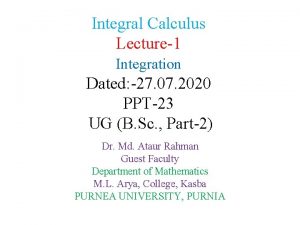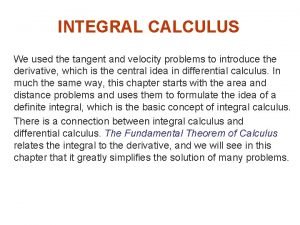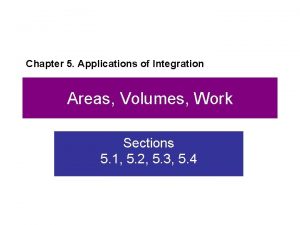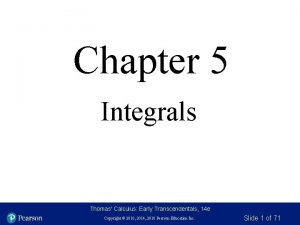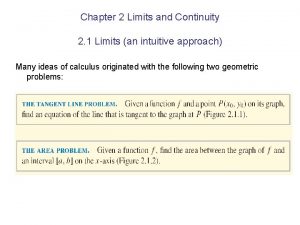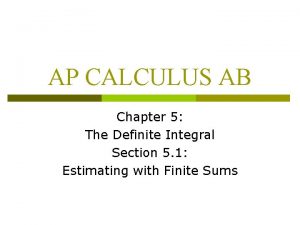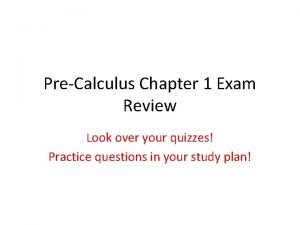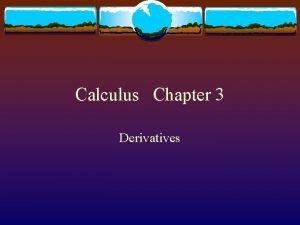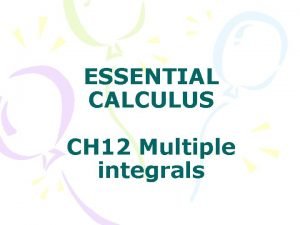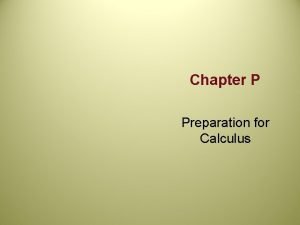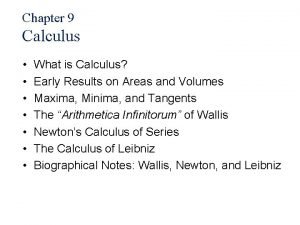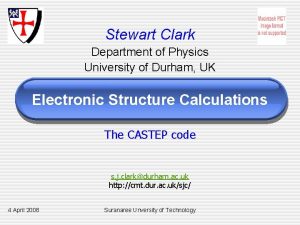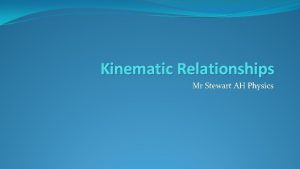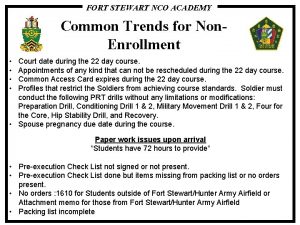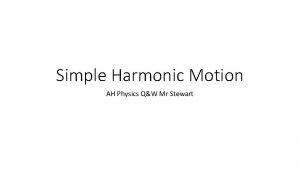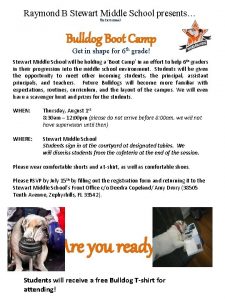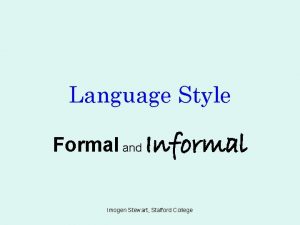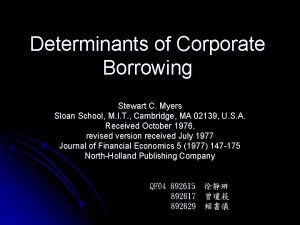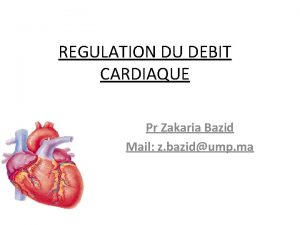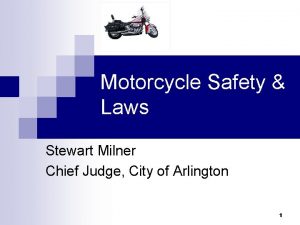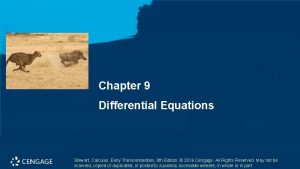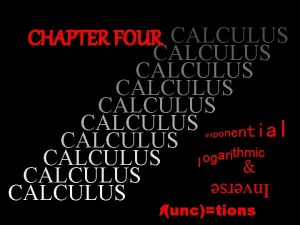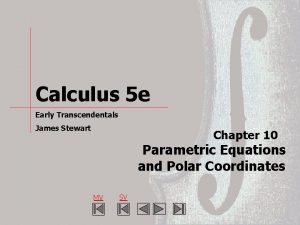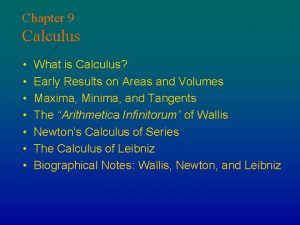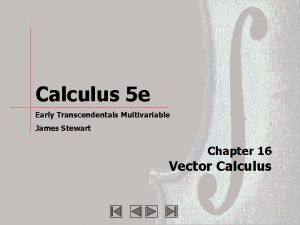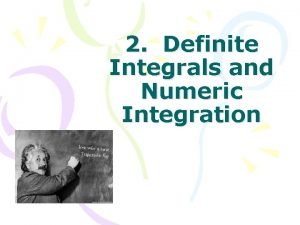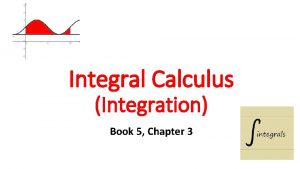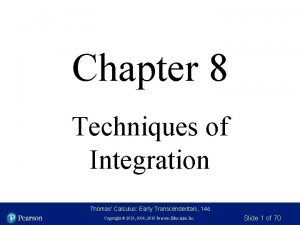Chapter 6 Applications of Integration Stewart Calculus Early

















































- Slides: 49

Chapter 6 Applications of Integration Stewart, Calculus: Early Transcendentals, 8 th Edition. © 2016 Cengage. All Rights Reserved. May not be scanned, copied or duplicated, or posted to a publicly accessible website, in whole or in part.

6. 1 Areas Between Curves Stewart, Calculus: Early Transcendentals, 8 th Edition. © 2016 Cengage. All Rights Reserved. May not be scanned, copied or duplicated, or posted to a publicly accessible website, in whole or in part.

Areas Between Curves (1 of 11) Consider the region S that lies between two curves y = f (x) and y = g(x) and between the vertical lines x = a and x = b, where f and g are continuous functions and f (x) ≥ g(x) for all x in [a, b]. (See Figure 1. ) Figure 1 Stewart, Calculus: Early Transcendentals, 8 th Edition. © 2016 Cengage. All Rights Reserved. May not be scanned, copied or duplicated, or posted to a publicly accessible website, in whole or in part.

Areas Between Curves (2 of 11) We divide S into n strips of equal width and then we approximate the i th strip by a rectangle with base Δx and height f (xi ) − g(xi ). (See Figure 2. If we like, we could take all of the sample points to be right endpoints, in which case xi = xi. ) (a) Typical rectangle (b) Approximating rectangles Figure 2 Stewart, Calculus: Early Transcendentals, 8 th Edition. © 2016 Cengage. All Rights Reserved. May not be scanned, copied or duplicated, or posted to a publicly accessible website, in whole or in part.

Areas Between Curves (3 of 11) The Riemann sum is therefore an approximation to what we intuitively think of as the area of S. This approximation appears to become better and better as n → ∞. Therefore we define the area A of the region S as the limiting value of the sum of the areas of these approximating rectangles. Stewart, Calculus: Early Transcendentals, 8 th Edition. © 2016 Cengage. All Rights Reserved. May not be scanned, copied or duplicated, or posted to a publicly accessible website, in whole or in part.

Areas Between Curves (4 of 11) We recognize the limit in (1) as the definite integral of f − g. Therefore we have the following formula for area. 2 The area A of the region bounded by the curves y = f(x), y = g(x), and the lines x = a, x = b, where f and g are continuous and f(x) ≥ g(x) for all x in [a, b] is Notice that in the special case where g(x) = 0, S is the region under the graph of f and our general definition of area (1) reduces. Stewart, Calculus: Early Transcendentals, 8 th Edition. © 2016 Cengage. All Rights Reserved. May not be scanned, copied or duplicated, or posted to a publicly accessible website, in whole or in part.

Areas Between Curves (5 of 11) In the case where both f and g are positive, you can see from Figure 3 why (2) is true: A = [area under y = f (x)] − [area under y = g(x)] Figure 3 Stewart, Calculus: Early Transcendentals, 8 th Edition. © 2016 Cengage. All Rights Reserved. May not be scanned, copied or duplicated, or posted to a publicly accessible website, in whole or in part.

Example 1 Find the area of the region bounded above by and bounded on the sides by x = 0 and x = 1. bounded below by y = x, Solution: The region is shown in Figure 4. The upper boundary curve is and the lower boundary curve is y = x. Figure 4 Stewart, Calculus: Early Transcendentals, 8 th Edition. © 2016 Cengage. All Rights Reserved. May not be scanned, copied or duplicated, or posted to a publicly accessible website, in whole or in part.

Example 1 – Solution So we use the area formula (2) with a = 0, and b = 1: Stewart, Calculus: Early Transcendentals, 8 th Edition. © 2016 Cengage. All Rights Reserved. May not be scanned, copied or duplicated, or posted to a publicly accessible website, in whole or in part.

Areas Between Curves (6 of 11) In Figure 4 we drew a typical approximating rectangle with width Δx as a reminder of the procedure by which the area is defined in (1). In general, when we set up an integral for an area, it’s helpful to sketch the region to identify the top curve y. T, the bottom curve y. B, and a typical approximating rectangle as in Figure 5. Figure 4 Stewart, Calculus: Early Transcendentals, 8 th Edition. © 2016 Cengage. All Rights Reserved. May not be scanned, copied or duplicated, or posted to a publicly accessible website, in whole or in part.

Areas Between Curves (7 of 11) Then the area of a typical rectangle is (y. T − y. B) Δx and the equation summarizes the procedure of adding (in a limiting sense) the areas of all the typical rectangles. Notice that in Figure 5 the left-hand boundary reduces to a point, whereas in Figure 3 the right-hand boundary reduces to a point. Figure 3 Stewart, Calculus: Early Transcendentals, 8 th Edition. © 2016 Cengage. All Rights Reserved. May not be scanned, copied or duplicated, or posted to a publicly accessible website, in whole or in part.

Areas Between Curves (8 of 11) If we are asked to find the area between the curves y = f(x) and y = g(x) where f(x) g(x) for some values x of but g(x) f(x) for other values of x, then we split the given region S into several regions S 1, S 2 , . . . with areas A 1, A 2 , . . . as shown in Figure 11. We then define the area of the region S to be the sum of the areas of the smaller regions S 1, S 2 , . . . , that is, A = A 1 + A 2 +. . Since Figure 11 Stewart, Calculus: Early Transcendentals, 8 th Edition. © 2016 Cengage. All Rights Reserved. May not be scanned, copied or duplicated, or posted to a publicly accessible website, in whole or in part.

Areas Between Curves (9 of 11) We have the following expression for A. 3 The area between the curves y = f(x) and y = g(x) and between x = a and x = b is When evaluating the integral in (3), however, we must still split it into integrals corresponding to A 1, A 2, …. Stewart, Calculus: Early Transcendentals, 8 th Edition. © 2016 Cengage. All Rights Reserved. May not be scanned, copied or duplicated, or posted to a publicly accessible website, in whole or in part.

Example 6 Find the area of the region bounded by the curves y = sin x, y = cos x, x = 0, and Solution: The points of intersection occur when sin x = cos x, that is, when The region is sketched in Figure 12. Observe that cos x sin x when sin x ≥ cos x when Figure 12 Stewart, Calculus: Early Transcendentals, 8 th Edition. © 2016 Cengage. All Rights Reserved. May not be scanned, copied or duplicated, or posted to a publicly accessible website, in whole or in part.

Example 6 – Solution (1 of 2) Therefore the required area is Stewart, Calculus: Early Transcendentals, 8 th Edition. © 2016 Cengage. All Rights Reserved. May not be scanned, copied or duplicated, or posted to a publicly accessible website, in whole or in part.

Example 6 – Solution (2 of 2) In this particular example we could have saved some work by noticing that the region is symmetric about Stewart, Calculus: Early Transcendentals, 8 th Edition. © 2016 Cengage. All Rights Reserved. May not be scanned, copied or duplicated, or posted to a publicly accessible website, in whole or in part.

Areas Between Curves (10 of 11) Some regions are best treated by regarding x as a function of y. If a region is bounded by curves with equations x = f (y), x = g (y), y = c, and y = d, where f and g are continuous and f (y) ≥ g (y) for c ≤ y ≤ d (see Figure 13), then its area is Figure 13 Stewart, Calculus: Early Transcendentals, 8 th Edition. © 2016 Cengage. All Rights Reserved. May not be scanned, copied or duplicated, or posted to a publicly accessible website, in whole or in part.

Areas Between Curves (11 of 11) If we write x. R for the right boundary and x. L for the left boundary, then, as Figure 14 illustrates, we have Figure 14 Stewart, Calculus: Early Transcendentals, 8 th Edition. © 2016 Cengage. All Rights Reserved. May not be scanned, copied or duplicated, or posted to a publicly accessible website, in whole or in part.

6. 2 Volumes Stewart, Calculus: Early Transcendentals, 8 th Edition. © 2016 Cengage. All Rights Reserved. May not be scanned, copied or duplicated, or posted to a publicly accessible website, in whole or in part.

Volumes (1 of 13) In trying to find the volume of a solid we face the same type of problem as in finding areas. We have an intuitive idea of what volume means, but we must make this idea precise by using calculus to give an exact definition of volume. Stewart, Calculus: Early Transcendentals, 8 th Edition. © 2016 Cengage. All Rights Reserved. May not be scanned, copied or duplicated, or posted to a publicly accessible website, in whole or in part.

Volumes (2 of 13) We start with a simple type of solid called a cylinder (or, more precisely, a right cylinder). As illustrated in Figure 1(a), a cylinder is bounded by a plane region B 1, called the base, and a congruent region B 2 in a parallel plane. Figure 1(a) The cylinder consists of all points on line segments that are perpendicular to the base and join B 1 to B 2. If the area of the base is A and the height of the cylinder (the distance from B 1 to B 2) is h, then the volume V of the cylinder is defined as V = Ah. Stewart, Calculus: Early Transcendentals, 8 th Edition. © 2016 Cengage. All Rights Reserved. May not be scanned, copied or duplicated, or posted to a publicly accessible website, in whole or in part.

Volumes (3 of 13) In particular, if the base is a circle with radius r, then the cylinder is a circular cylinder with volume [see Figure 1(b)], and if the base is a rectangle with length l and width w, then the cylinder is a rectangular box (also called a rectangular parallelepiped) with volume V = lwh [see Figure 1(c)]. Figure 1(b) Figure 1(c) Stewart, Calculus: Early Transcendentals, 8 th Edition. © 2016 Cengage. All Rights Reserved. May not be scanned, copied or duplicated, or posted to a publicly accessible website, in whole or in part.

Volumes (4 of 13) For a solid S that isn’t a cylinder we first “cut” S into pieces and approximate each piece by a cylinder. We estimate the volume of S by adding the volumes of the cylinders. We arrive at the exact volume of S through a limiting process in which the number of pieces becomes large. We start by intersecting S with a plane and obtaining a plane region that is called a cross-section of S. Stewart, Calculus: Early Transcendentals, 8 th Edition. © 2016 Cengage. All Rights Reserved. May not be scanned, copied or duplicated, or posted to a publicly accessible website, in whole or in part.

Volumes (5 of 13) Let A(x) be the area of the cross-section of S in a plane Px perpendicular to the x-axis and passing through the point x, where a ≤ x ≤ b. (See Figure 2. Think of slicing S with a knife through x and computing the area of this slice. ) The cross-sectional area A(x) will vary as x increases from a to b. Figure 2 Stewart, Calculus: Early Transcendentals, 8 th Edition. © 2016 Cengage. All Rights Reserved. May not be scanned, copied or duplicated, or posted to a publicly accessible website, in whole or in part.

Volumes (6 of 13) Let’s divide S into n “slabs” of equal width Δx by using the planes Px , . . . 1 2 to slice the solid. (Think of slicing a loaf of bread. ) If we choose sample points xi in [xi – 1, xi], we can approximate the i th slab Si (the part of S that lies between the planes Px and Px ) by a cylinder with i– 1 i base area A (xi ) and “height” Δx. (See Figure 3. ) Figure 3 Stewart, Calculus: Early Transcendentals, 8 th Edition. © 2016 Cengage. All Rights Reserved. May not be scanned, copied or duplicated, or posted to a publicly accessible website, in whole or in part.

Volumes (7 of 13) The volume of this cylinder is A (xi ) Δx, so an approximation to our intuitive conception of the volume of the i th slab Si is Adding the volumes of these slabs, we get an approximation to the total volume (that is, what we think of intuitively as the volume): Stewart, Calculus: Early Transcendentals, 8 th Edition. © 2016 Cengage. All Rights Reserved. May not be scanned, copied or duplicated, or posted to a publicly accessible website, in whole or in part.

Volumes (8 of 13) This approximation appears to become better and better as n ∞. (Think of the slices as becoming thinner and thinner. ) Therefore we define the volume as the limit of these sums as n ∞. But we recognize the limit of Riemann sums as a definite integral and so we have the following definition. Definition of Volume Let S be a solid that lies between x = a and x = b. If the cross-sectional area of S in the plane Px, through x and perpendicular to the xaxis, is A(x), where A is a continuous function, then the volume of S is Stewart, Calculus: Early Transcendentals, 8 th Edition. © 2016 Cengage. All Rights Reserved. May not be scanned, copied or duplicated, or posted to a publicly accessible website, in whole or in part.

Volumes (9 of 13) When we use the volume formula it is important to remember that A(x) is the area of a moving cross-section obtained by slicing through x perpendicular to the x-axis. Notice that, for a cylinder, the cross-sectional area is constant: A(x) = A for all x. So our definition of volume gives this agrees with the formula V = Ah. Stewart, Calculus: Early Transcendentals, 8 th Edition. © 2016 Cengage. All Rights Reserved. May not be scanned, copied or duplicated, or posted to a publicly accessible website, in whole or in part.

Example 1 Show that the volume of a sphere of radius r is Solution: If we place the sphere so that its center is at the origin, then the plane Px intersects the sphere in a circle whose radius (from the Pythagorean Theorem) is (See Figure 4. ) So the cross-sectional area is Figure 4 Stewart, Calculus: Early Transcendentals, 8 th Edition. © 2016 Cengage. All Rights Reserved. May not be scanned, copied or duplicated, or posted to a publicly accessible website, in whole or in part.

Example 1 – Solution Using the definition of volume with a = −r and b = r, we have Stewart, Calculus: Early Transcendentals, 8 th Edition. © 2016 Cengage. All Rights Reserved. May not be scanned, copied or duplicated, or posted to a publicly accessible website, in whole or in part.

Volumes (10 of 13) Figure 5 illustrates the definition of volume when the solid is a sphere with radius r = 1. From the result of Example 1, we know that the volume of the sphere is which is approximately 4. 18879. Approximating the volume of a sphere with radius 1 Figure 5 Stewart, Calculus: Early Transcendentals, 8 th Edition. © 2016 Cengage. All Rights Reserved. May not be scanned, copied or duplicated, or posted to a publicly accessible website, in whole or in part.

Volumes (11 of 13) Here the slabs are circular cylinders, or disks, and the three parts of Figure 5 show the geometric interpretations of the Riemann sums when n = 5, 10, and 20 if we choose the sample points xi to be the midpoints Notice that as we increase the number of approximating cylinders, the corresponding Riemann sums become closer to the true volume. Stewart, Calculus: Early Transcendentals, 8 th Edition. © 2016 Cengage. All Rights Reserved. May not be scanned, copied or duplicated, or posted to a publicly accessible website, in whole or in part.

Volumes (12 of 13) The solids are all called solids of revolution because they are obtained by revolving a region about a line. In general, we calculate the volume of a solid of revolution by using the basic defining formula and we find the cross-sectional area A(x) or A(y) in one of the following ways: • If the cross-section is a disk, we find the radius of the disk (in terms of x or y) and use Stewart, Calculus: Early Transcendentals, 8 th Edition. © 2016 Cengage. All Rights Reserved. May not be scanned, copied or duplicated, or posted to a publicly accessible website, in whole or in part.

Volumes (13 of 13) • If the cross-section is a washer, we find the inner radius rin and outer radius rout from a sketch (as in Figure 10) and compute the area of the washer by subtracting the area of the inner disk from the area of the outer disk: Figure 10 Stewart, Calculus: Early Transcendentals, 8 th Edition. © 2016 Cengage. All Rights Reserved. May not be scanned, copied or duplicated, or posted to a publicly accessible website, in whole or in part.

6. 3 Volumes by Cylindrical Shells Stewart, Calculus: Early Transcendentals, 8 th Edition. © 2016 Cengage. All Rights Reserved. May not be scanned, copied or duplicated, or posted to a publicly accessible website, in whole or in part.

Volumes by Cylindrical Shells (1 of 9) Let’s consider the problem of finding the volume of the solid obtained by rotating about the y-axis the region bounded by (See Figure 1. ) Figure 1 If we slice perpendicular to the y-axis, we get a washer. Stewart, Calculus: Early Transcendentals, 8 th Edition. © 2016 Cengage. All Rights Reserved. May not be scanned, copied or duplicated, or posted to a publicly accessible website, in whole or in part.

Volumes by Cylindrical Shells (2 of 9) But to compute the inner radius and the outer radius of the washer, we’d have to solve the cubic equation for x in terms of y; that’s not easy. Fortunately, there is a method, called the method of cylindrical shells, that is easier to use in such a case. Figure 2 shows a cylindrical shell with inner radius r 1, outer radius r 2, and height h. Figure 2 Stewart, Calculus: Early Transcendentals, 8 th Edition. © 2016 Cengage. All Rights Reserved. May not be scanned, copied or duplicated, or posted to a publicly accessible website, in whole or in part.

Volumes by Cylindrical Shells (3 of 9) Its volume V is calculated by subtracting the volume V 1 of the inner cylinder from the volume V 2 of the outer cylinder: Stewart, Calculus: Early Transcendentals, 8 th Edition. © 2016 Cengage. All Rights Reserved. May not be scanned, copied or duplicated, or posted to a publicly accessible website, in whole or in part.

Volumes by Cylindrical Shells (4 of 9) If we let Δr = r 2 – r 1 (the thickness of the shell) and (the average radius of the shell), then this formula for the volume of a cylindrical shell becomes and it can be remembered as V = [circumference] [height] [thickness] Stewart, Calculus: Early Transcendentals, 8 th Edition. © 2016 Cengage. All Rights Reserved. May not be scanned, copied or duplicated, or posted to a publicly accessible website, in whole or in part.

Volumes by Cylindrical Shells (5 of 9) Now let S be the solid obtained by rotating about the y-axis the region bounded by y = f(x) [where f(x) ≥ 0], y = 0, x = a, and x = b, where b > a ≥ 0. (See Figure 3. ) Figure 3 We divide the interval [a, b] into n subintervals [xi – 1, xi] of equal width Δx and let be the midpoint of the ith subinterval. Stewart, Calculus: Early Transcendentals, 8 th Edition. © 2016 Cengage. All Rights Reserved. May not be scanned, copied or duplicated, or posted to a publicly accessible website, in whole or in part.

Volumes by Cylindrical Shells (6 of 9) If the rectangle with base [xi − 1, xi] and height is rotated about the y-axis, then the result is a cylindrical shell with average radius and thickness Δx (see Figure 4), so by Formula 1 its volume is Figure 4 Stewart, Calculus: Early Transcendentals, 8 th Edition. © 2016 Cengage. All Rights Reserved. May not be scanned, copied or duplicated, or posted to a publicly accessible website, in whole or in part.

Volumes by Cylindrical Shells (7 of 9) Therefore an approximation to the volume V of S is given by the sum of the volumes of these shells: This approximation appears to become better as n ∞. But, from the definition of an integral, we know that Stewart, Calculus: Early Transcendentals, 8 th Edition. © 2016 Cengage. All Rights Reserved. May not be scanned, copied or duplicated, or posted to a publicly accessible website, in whole or in part.

Volumes by Cylindrical Shells (8 of 9) Thus the following appears plausible: 2 The volume of the solid in Figure 3, obtained by rotating about the y-axis the region under the curve y = f(x) from a to b, is Stewart, Calculus: Early Transcendentals, 8 th Edition. © 2016 Cengage. All Rights Reserved. May not be scanned, copied or duplicated, or posted to a publicly accessible website, in whole or in part.

Volumes by Cylindrical Shells (9 of 9) The best way to remember Formula 2 is to think of a typical shell, cut and flattened as in Figure 5, with radius x, circumference 2 x, height f(x), and thickness Δx or dx: Figure 5 This type of reasoning will be helpful in other situations, such as when we rotate about lines other than the y-axis. Stewart, Calculus: Early Transcendentals, 8 th Edition. © 2016 Cengage. All Rights Reserved. May not be scanned, copied or duplicated, or posted to a publicly accessible website, in whole or in part.

Example 1 Find the volume of the solid obtained by rotating about the y-axis the region bounded by Solution: From the sketch in Figure 6 we see that a typical shell has radius x, circumference 2πx, and height Figure 6 Stewart, Calculus: Early Transcendentals, 8 th Edition. © 2016 Cengage. All Rights Reserved. May not be scanned, copied or duplicated, or posted to a publicly accessible website, in whole or in part.

Example 1 – Solution So, by the shell method, the volume is It can be verified that the shell method gives the same answer as slicing. Stewart, Calculus: Early Transcendentals, 8 th Edition. © 2016 Cengage. All Rights Reserved. May not be scanned, copied or duplicated, or posted to a publicly accessible website, in whole or in part.

Disks and Washers versus Cylindrical Shells Stewart, Calculus: Early Transcendentals, 8 th Edition. © 2016 Cengage. All Rights Reserved. May not be scanned, copied or duplicated, or posted to a publicly accessible website, in whole or in part.

Disks and Washers versus Cylindrical Shells (1 of 2) When computing the volume of a solid of revolution, how do we know whether to use disks (or washers) or cylindrical shells? There are several considerations to take into account: Is the region more easily described by top and bottom boundary curves of the form y = f(x) or by left and right boundaries x = g(y)? Which choice is easier to work with? Are the limits of integration easier to find for one variable versus the other? Does the region require two separate integrals when using x as the variable but only one integral in y? Are we able to evaluate the integral we set up with our choice of variable? Stewart, Calculus: Early Transcendentals, 8 th Edition. © 2016 Cengage. All Rights Reserved. May not be scanned, copied or duplicated, or posted to a publicly accessible website, in whole or in part.

Disks and Washers versus Cylindrical Shells (2 of 2) If we decide that one variable is easier to work with than the other, then this dictates which method to use. Draw a sample rectangle in the region, corresponding to a crosssection of the solid. The thickness of the rectangle, either Δx or Δy, corresponds to the integration variable. If you imagine the rectangle revolving, it becomes either a disk (washer) or a shell. Stewart, Calculus: Early Transcendentals, 8 th Edition. © 2016 Cengage. All Rights Reserved. May not be scanned, copied or duplicated, or posted to a publicly accessible website, in whole or in part.
 Stewart
Stewart Integral rules
Integral rules Nguyên hàm
Nguyên hàm Further applications of integration
Further applications of integration Further applications of integration
Further applications of integration Applications of integration volume
Applications of integration volume Further applications of integration
Further applications of integration Further applications of integration
Further applications of integration Further applications of integration
Further applications of integration Further applications of integration
Further applications of integration Early cpr and early defibrillation can: *
Early cpr and early defibrillation can: * Three dimensions of corporate strategy
Three dimensions of corporate strategy Backwards intergration
Backwards intergration Example of simultaneous integration
Example of simultaneous integration Calculus chapter 5 integrals
Calculus chapter 5 integrals Chapter 2 limits and continuity
Chapter 2 limits and continuity Ap calc ab chapter 5
Ap calc ab chapter 5 Pre calculus chapter 1
Pre calculus chapter 1 Calculus chapter 3
Calculus chapter 3 Calculus chapter 12
Calculus chapter 12 Chapter p preparation for calculus
Chapter p preparation for calculus What is calculus
What is calculus Stewart clark durham
Stewart clark durham Compliance in psychology
Compliance in psychology Prueba de stewart holmes
Prueba de stewart holmes Selina stewart
Selina stewart Mr stewart physics
Mr stewart physics Paul cardall life and death
Paul cardall life and death Bethany williams love rosie
Bethany williams love rosie Mr stewart physics
Mr stewart physics Ah physics relationship sheet
Ah physics relationship sheet Nco academy fort stewart
Nco academy fort stewart Fort bragg dpw
Fort bragg dpw Dalil stewart
Dalil stewart Mr stewart physics
Mr stewart physics Raymond b stewart middle school
Raymond b stewart middle school Manoeuvre de stewart holmes
Manoeuvre de stewart holmes Stewart stafford
Stewart stafford Stewart myers mit
Stewart myers mit Jan stewart crna
Jan stewart crna Méthode de stewart hamilton
Méthode de stewart hamilton Stuart milner
Stuart milner Stewart county open forum
Stewart county open forum Martha stewart 1991
Martha stewart 1991 Neal stewart designs
Neal stewart designs Clasificación de stewart-way
Clasificación de stewart-way Erie railroad v stewart
Erie railroad v stewart Stewart differential equations
Stewart differential equations Liam stewart
Liam stewart Richard stewart family learning centre
Richard stewart family learning centre

